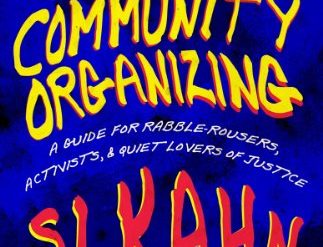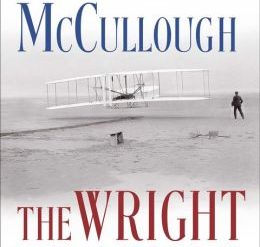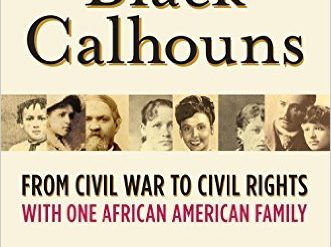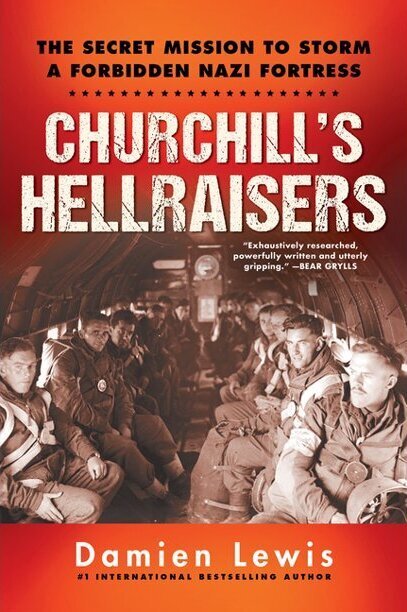
Estimated reading time: 8 minutes
You might think everything that could have been written about World War II has already reached a wider public, especially now that even the oldest veterans and survivors are passing from the scene. But you would be wrong. An excellent case in point is British author Damien Lewis’ Churchill’s Hellraisers. The book’s subtitle suggests it’s a conventional account of yet another heroic raid on a Nazi strongpoint. But it’s more than that. Woven into Lewis’ breathtaking tale of extraordinary courage and resourcefulness by British special forces and Italian partisans is a deplorable story of political interference in the conduct of the war.
Weakening the Nazis’ Gothic Line from behind
The central topic of Churchill’s Hellraisers is Operation Tombola, which unfolded in northern Italy in the closing weeks of World War II. Despite the collapse of Nazi forces on both the Eastern and Western Fronts, the German 10th and 14th Armies lay dug into seemingly impregnable defensive positions on the Gothic Line that lay high across the calf of the Italian peninsula. The Allied drive north through Italy was stalled. Tombola was conceived to create havoc behind the line in support of an Allied offensive to break through and drive the Nazis from the country. There, British special forces would ally with Italian partisans to do what seemed impossible. And it worked. But there’s much more to the story.
Churchill’s Hellraisers: The Secret WWII Mission to Storm a Forbidden Nazi Fortress by Damien Lewis (2020) 291 pages ★★★★☆
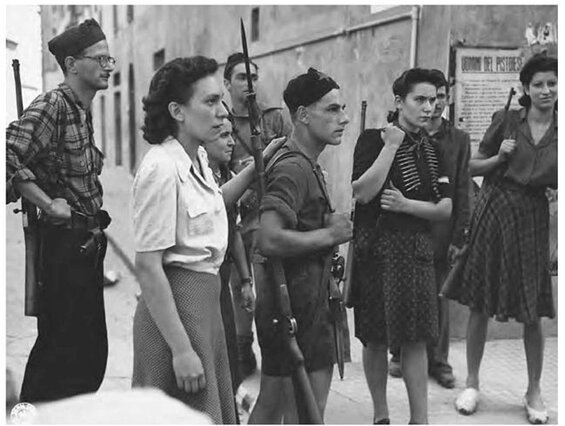
Two extraordinary members of the British special forces
Two remarkable men are the central characters in Lewis’ account. They’re the field commanders of the mission to storm the German 14th Army Headquarters in March 1945.
Michael Lees
Captain Michael Lees (1922-93) was a member of an aristocratic English family with a distinguished war record. After service in the British army, he volunteered for the Special Operations Executive and served on a perilous assignment with the Chetnik partisans in Yugoslavia before being sent to Italy. In September 1944, he parachuted into the Reggiani Valley in the rugged country of the Apennine Mountains near the Western end of the Gothic Line. To stiffen partisan resistance to the Nazis there, he organized and trained a 300-person multinational force including Spanish Republicans who had fled the Franco regime, Russian POWs, and escaped slave laborers as well as Italian partisans hand-picked from hundreds in the valley. Lees was the principal planner of Operation Tombola.
Roy Farran
To take command of Operation Tombola, Major Roy Farran (1921-2006) of the Special Air Service parachuted into the Reggiani Valley against express orders to do so. (On March 4, 1945, he “accidentally” fell out of the aircraft that was ferrying troops and equipment to join Lees.) Proceeding on schedule, he and Lees moved a force of 100 men out on a difficult march toward the German 14th Army Headquarters. They left 200 behind to secure the valley, convinced there would be a massive reprisal by the Nazis. Not long before their force was in position to launch the attack, they received frantic last-minute orders by messenger to stand down.
Knowing that delay would destroy the partisans’ morale and ensure no attack ever took place, they went ahead against orders. In the event, the attack was remarkably successful. And even though Allied forces weren’t ready to assault the Gothic Line—the reason for the order to delay the mission—they had caused so much disruption within the German army that the breakthrough succeeded.
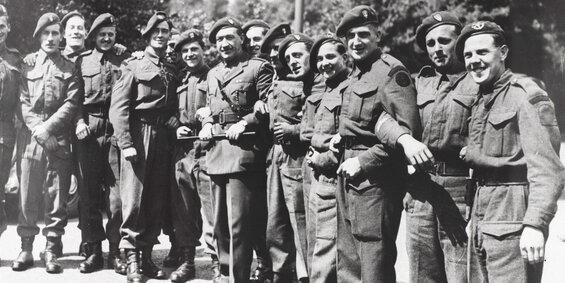
Perspective on unfamiliar aspects of the war
Churchill’s Hellraisers brings to light three aspects of the war that haven’t come to light in any of my other reading.
The role of propaganda
Most accounts of partisan operations in Europe note the role of the BBC in transmitting attack orders to British special forces and their partisan collaborators. But the BBC and other Allied radio operations also played a major role in building and sustaining the morale of isolated partisan bands by broadcasting news of successful operations. Lewis makes clear in his tale of Operation Tombola that such broadcasts helped stiffen the spines of guerrilla bands involved in Italy as well as elsewhere. Since large-scale partisan operations didn’t get underway until late in the war, when an Allied victory seemed inevitable, there were many opportunities to brag about the damage they were inflicting on the Germans.
Betrayal of the Italian partisans
In the most dramatic revelation in Churchill’s Hellraisers, Lewis details how anti-Communist zealots in the British Cabinet and US State Department overrode military decisions to continue supporting the Italian partisans. Knowing that most of those involved in anti-Nazi efforts in northern Italy were Communists, officials feared that arming them would lead to a Communist takeover of the country following the war. With orders coming down from on high, mid-ranking officers in the field had little choice but to curtail shipments of arms and supplies.
British special forces commanders in the field such as Lees and Farran raged at the betrayal, which undermined their operations. A few well-connected officers, the two leaders of Operation Tombola among them, managed to wheedle the necessary support despite the fears of the politicians. And, in the event, the Italian Communist partisans never made any move to seize control of the government or set up a rival power center. They entered politics instead.
Multinational character of the fighting forces
British special forces and Italian partisans didn’t carry the fight to the Nazis on their own. Nearly one-third of the 100-man attack force Farran and Lees led to the 14th Army headquarters were Russians. Many were escaped POWs, others slave laborers sent to factories in Central Europe. In addition, a significant number of Spaniards who had fled Francisco Franco’s regime took part in the operation as well. In fact, the polyglot nature of the force presented a special challenge to Major Farran. To facilitate the all-important communication with the Russians, he brought across the line an Austrian Jewish soldier who spoke German with the Russian commander.
Churchill’s Hellraisers doesn’t read like a thriller
Reviewers crow over accounts of World War II that “read like a thriller.” Churchill’s Hellraisers does not. In fact, the book is tough sledding at times, especially for an American reader.
- The subtitle suggests that Operation Tombola is the book’s subject. But Major Farran, the mission’s commander, doesn’t arrive on the scene until halfway through the story. The first half introduces him and Captain Lees in a rambling account of numerous other officers and men and the special operations they carried out not just in Italy but throughout Europe and North Africa.
- Although Lewis spotlights the two central figures, he delights in introducing scores of other colorful characters, each depicted in an information-packed paragraph or two. The author describes their varied experience in Italy, Spain, France, Norway, Yugoslavia, and North Africa. It’s all too easy to find yourself on page 200 trying to remember a soldier first mentioned a hundred pages earlier.
- It’s difficult to tell where the orders come from, or who’s in charge. In fairness, the men in the field often felt equally confused. But it’s worse for a reader. Lewis brings all the different British special forces commands into the tale: the Special Operations Executive (SOE), Special Air Service (SAS), and Special Boat Service (SBS). Even the Commandos and MI6 get mentioned. And, on top of all that, a confusing welter of majors, colonels, and generals get into the act as well, some British, some American.
- And the author sees fit to season his account with colloquial British words and phrases so obscure that I’ve never come across them anywhere else.
Churchill’s Hellraisers might have benefited from an aggressive editor.
About the author

Damien Lewis is NOT the British actor who starred in Band of Brothers, Homeland, and Billions. HE spells his first name with two a’s (Damian, not Damien). The author is a British filmmaker who has written eighteen nonfiction books, many of them about war and warriors, as well as two thrillers. Wikipedia notes that he “has spent over twenty years reporting from and writing about conflict zones in many countries. He has produced about twenty films.”
For related reading
This book is one of 10 true-life accounts of anti-Nazi resistance.
I’ve also reviewed another of Damien Lewis’ books about WWII, Churchill’s Shadow Raiders: The Race to Develop Radar, WWII’s Invisible Secret Weapon (How German radar technology helped Britain win World War II).
For more information about British special forces in World War II, see Rogue Heroes: The History of the SAS, Britain’s Secret Special Forces Unit that Sabotaged the Nazis and Changed the Nature of War by Ben MacIntyre (The story of the original special forces) and Female spies and saboteurs in World War II.
You might also enjoy:
- 10 top nonfiction books about World War II
- The 10 best novels about World War II
- Good books about the Holocaust
- 7 common misconceptions about World War II
- The 10 most consequential events of World War II
- Top 20 popular books for understanding American history
And you can always find my most popular reviews, and the most recent ones, on the Home Page.

